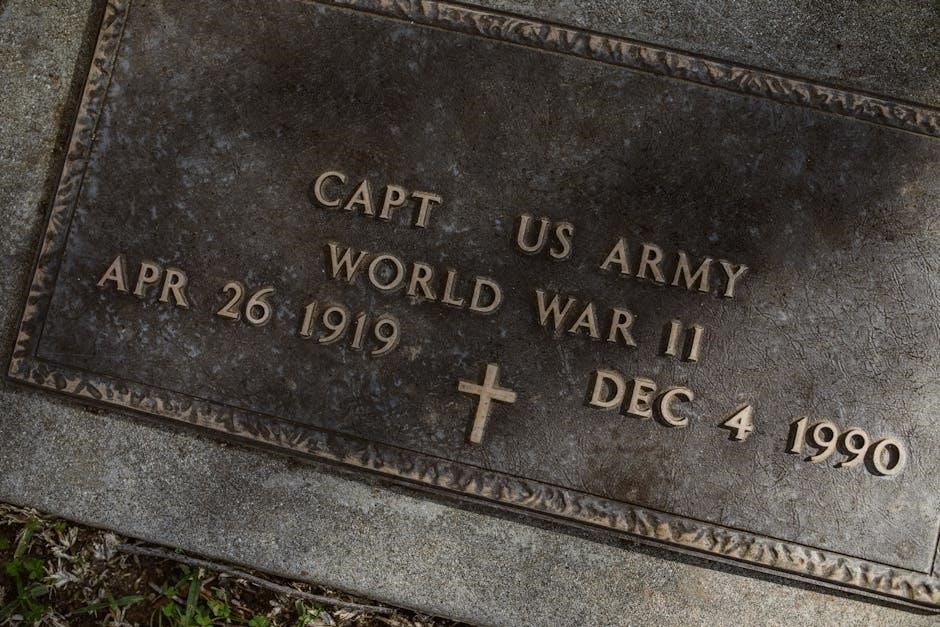The Funeral Rosary is a Catholic tradition offering prayers for the deceased, typically including the Our Father, Hail Mary, and Eternal Rest prayer, providing comfort to mourners.
1.1. Definition and Purpose
The Funeral Rosary is a Catholic prayer tradition used to honor the deceased and seek eternal rest for their soul. It combines the Our Father, Hail Mary, and Eternal Rest prayer, offering comfort to mourners. Typically prayed during funeral vigils or services, it serves as a spiritual farewell, helping the family and community find solace in faith. The rosary’s purpose is to pray for the deceased’s journey to heaven, while also providing a sense of unity and support for those grieving. This practice reflects Catholic beliefs in the power of prayer to assist the soul after death, emphasizing compassion and hope.
1.2. Historical Background
The Funeral Rosary traces its origins to early Catholic traditions, evolving from the medieval practice of praying with beads. Initially, it was a devotion to the Virgin Mary, later adapting to include prayers for the deceased. The rosary became a staple in Catholic funeral rites, particularly after the Council of Trent, which emphasized prayer for the dead. Over centuries, it has remained a vital part of Catholic mourning practices, offering a structured way to seek divine mercy for the departed soul. This tradition reflects the Church’s enduring belief in the efficacy of prayer to aid the soul’s journey to eternal life, while comforting the living through communal worship.
1.3. Structure and Components
The Funeral Rosary is structured around traditional Catholic prayers, including the Apostles’ Creed, the Our Father, Hail Mary, and the Glory Be. It often incorporates the Eternal Rest prayer, specifically for the deceased. The rosary beads provide a tactile guide, helping participants navigate the sequence of prayers. Each decade typically includes an Our Father, followed by ten Hail Marys, and concludes with a Glory Be. The prayers are recited in a communal setting, fostering unity among mourners. This structured format ensures a focused and meaningful devotion, offering comfort to the grieving while interceding for the soul of the departed.

What is the Funeral Rosary?
The Funeral Rosary is a Catholic tradition of praying for the deceased, incorporating specific prayers like the Our Father, Hail Mary, and Eternal Rest prayer, offering comfort to mourners.
2.1. The Role of the Rosary in Catholic Funeral Traditions

The Funeral Rosary holds a significant role in Catholic funeral traditions, serving as a devout prayer for the soul of the deceased. It is often recited during the funeral vigil or visitation, providing solace to the grieving family and friends. The rosary’s prayers, such as the Our Father and Hail Mary, are believed to assist the departed in their journey to eternal life. Additionally, the Eternal Rest prayer is specifically included to seek divine rest for the soul. This tradition strengthens the community’s bond as mourners come together to pray, offering both spiritual support and a collective expression of faith. The rosary thus becomes a meaningful ritual in Catholic funeral practices, blending devotion and comfort seamlessly.
2.2. The Difference Between the Funeral Rosary and the Traditional Rosary
The Funeral Rosary differs from the Traditional Rosary primarily in its purpose and structure. While the Traditional Rosary focuses on meditating on the Mysteries of the Rosary, the Funeral Rosary is specifically prayed for the soul of the deceased. It often includes additional prayers, such as the Eternal Rest prayer, and may omit some of the traditional elements like the Glory Be after each decade. The Funeral Rosary is typically shorter and more solemn, recited during a funeral vigil or visitation. Its primary intention is to seek divine mercy and eternal rest for the departed, making it a unique and solemn adaptation of the traditional prayer.
2.3. The Significance of the Funeral Rosary in Mourning
The Funeral Rosary holds profound significance in the mourning process, offering solace to the bereaved and spiritual support for the deceased. It serves as a comforting ritual, allowing mourners to come together and pray for the soul of the departed. The recitation of prayers like the Our Father, Hail Mary, and Eternal Rest prayer creates a sense of unity and shared purpose among those grieving. This practice not only honors the deceased but also provides a meaningful way to cope with loss, fostering hope and reassurance through its focus on eternal rest and divine mercy. The Funeral Rosary is a cherished tradition that bridges the earthly and heavenly realms, bringing comfort to those in sorrow.

How to Pray the Funeral Rosary
The Funeral Rosary begins with the Apostles Creed, followed by the Our Father, Hail Mary, and Glory Be. Each mystery is prayed with these prayers, concluding with the Eternal Rest prayer for the deceased.
3.1. Step-by-Step Guide to Praying the Funeral Rosary
The Funeral Rosary begins with the Apostles Creed, led by the prayer leader. Follow with the Our Father, three Hail Marys, and a Glory Be. Each mystery is prayed similarly, with the leader announcing the mystery and participants responding with the prayers. After the fifth mystery, the Eternal Rest prayer is recited for the deceased. This structure provides a solemn and structured way to honor the departed while seeking divine mercy and comfort for the mourners. The leader guides the flow, ensuring all participants can follow and pray together meaningfully. This step-by-step approach ensures unity and devotion during the solemn occasion.
3.2. The Role of the Leader and Participants
The leader initiates each prayer, announces the mysteries, and ensures the Funeral Rosary progresses smoothly. Participants respond to the leader, reciting prayers in unison and engaging in silent reflection. The leader’s role is to guide the group, while participants actively join in the prayers, creating a collective expression of faith and mourning; This shared participation fosters unity and provides emotional support to the grieving family. The leader also invites the group to recite specific prayers, such as the Eternal Rest prayer, emphasizing the communal aspect of praying for the deceased. Both roles are essential to the meaningful observance of the Funeral Rosary, ensuring a reverent and organized prayer service.

3.3. Incorporating the Eternal Rest Prayer
The Eternal Rest Prayer is a central component of the Funeral Rosary, typically recited after each decade. It seeks divine mercy and eternal peace for the deceased, emphasizing rest from earthly labors. This prayer is often led by the leader and repeated by participants, creating a solemn and unifying moment of intercession. Its inclusion underscores the Funeral Rosary’s purpose of praying for the soul’s repose, while also offering comfort to the grieving. The prayer’s repetition reinforces the community’s collective plea for the deceased’s eternal rest, fostering a sense of shared faith and solidarity among mourners. It is a poignant expression of Catholic devotion and hope in eternal life.

When and Where is the Funeral Rosary Typically Prayed?
The Funeral Rosary is commonly prayed during the funeral vigil, at the funeral home, or in the church, often before the Mass or burial service begins.
4.1. During the Funeral Vigil
The Funeral Rosary is often prayed during the funeral vigil, typically held the evening before the funeral. This solemn gathering provides an opportunity for family and friends to come together, offering prayers for the deceased. The vigil usually includes the recitation of the rosary, with specific prayers such as the Our Father, Hail Mary, and Eternal Rest prayer, which are central to the Funeral Rosary tradition. The rosary is often led by a priest or designated leader, guiding the participants through the mysteries and prayers. Praying the Funeral Rosary during the vigil helps to console the grieving and seek divine mercy for the soul of the departed. It is a meaningful way to honor the deceased and find solace in faith and community.
4.2. At the Funeral Home or Church
The Funeral Rosary is commonly prayed at the funeral home or church, serving as a central part of Catholic funeral traditions. This setting provides a sacred space for mourners to gather and offer prayers for the deceased. The rosary is typically led by a priest or a designated leader, who guides the participants through the prayers and mysteries. The recitation of the Our Father, Hail Mary, and Eternal Rest prayer is integral to this practice, offering solace to those grieving. Praying the Funeral Rosary in such a venue emphasizes the community’s collective support and faith, while also honoring the departed soul. It is a profound way to seek divine mercy and comfort during a time of loss.
4.3. Graveside or Memorial Services
The Funeral Rosary may also be prayed at graveside or during memorial services, providing a solemn conclusion to the farewell rites. This intimate setting allows mourners to reflect on the deceased’s life and eternal rest. The rosary’s prayers, such as the Our Father and Hail Mary, are recited to seek divine mercy and comfort. Graveside recitation often includes the Eternal Rest prayer, emphasizing hope for the soul’s peaceful transition. This practice strengthens the community’s bond and offers solace to those grieving. Praying the Funeral Rosary at the graveside or memorial service serves as a final act of love and faith, honoring the departed while seeking healing for the living.

The Significance of Specific Prayers in the Funeral Rosary
The Funeral Rosary includes specific prayers like the Our Father, Hail Mary, and Eternal Rest, seeking forgiveness, comfort, and eternal peace for the deceased.
5.1. The Our Father
The Our Father is central in the Funeral Rosary, prayed for divine forgiveness and protection. It reflects hope for eternal life, seeking comfort and solace for the bereaved.
5.2. The Hail Mary
The Hail Mary is a cornerstone prayer in the Funeral Rosary, seeking divine mercy and intercession for the deceased. It honors the Blessed Virgin Mary, imploring her prayers for the soul’s eternal rest. Recited repeatedly, the Hail Mary expresses sorrow and hope, offering comfort to mourners. Its familiar words provide solace, reminding the faithful of Mary’s maternal care and Christ’s redemptive power. This prayer is integral to the rosary’s structure, fostering devotion and communal support during bereavement. The Hail Mary’s repetition emphasizes trust in God’s plan and the hope of eternal life. It is a poignant expression of faith and love, bridging earthly grief with heavenly hope.
5.3. The Eternal Rest Prayer
The Eternal Rest Prayer is a central devotion in the Funeral Rosary, offering solace to mourners and interceding for the deceased. It seeks eternal rest and divine mercy for the soul, emphasizing trust in God’s plan. This prayer, often recited after the Hail Mary, provides comfort by focusing on peace and redemption. It is a poignant expression of faith, reinforcing the belief in eternal life and the hope of reunion. The Eternal Rest Prayer strengthens the community’s bond, uniting all in prayer for the departed. Its inclusion in the Funeral Rosary underscores its significance in Catholic tradition, offering a powerful way to honor and remember loved ones.

The Importance of the Funeral Rosary in Catholic Tradition
The Funeral Rosary is a vital tradition offering comfort, interceding for the deceased, and uniting the community in prayer, reflecting deep faith and devotion.
6.1. Seeking Comfort and Solace
The Funeral Rosary provides profound comfort to those grieving, offering a sense of peace through prayer. It helps mourners cope with loss by focusing on the deceased’s spiritual journey. The repetitive recitation of prayers like the Our Father and Hail Mary creates a calming rhythm, easing emotional pain. The Eternal Rest prayer specifically seeks rest for the deceased, bringing solace to the bereaved. This communal prayer strengthens faith and reminds participants of eternal life, offering hope and reassurance during difficult times. It unites families and friends, fostering a shared sense of support and spiritual connection.
6.2. Praying for the Deceased
Praying for the deceased is a central aspect of the Funeral Rosary, emphasizing the Catholic belief in purgatory and the need for spiritual purification. The rosary’s prayers, such as the Our Father, Hail Mary, and Eternal Rest, are offered to assist the soul’s journey toward heaven. These prayers seek divine mercy, forgiveness, and eternal peace for the departed. By praying for the deceased, mourners actively participate in their spiritual support, demonstrating love and solidarity. The Funeral Rosary also comforts the living by focusing on the hope of eternal life and the promise of divine compassion. This practice reinforces the belief that prayer can ease the soul’s transition and bring solace to those grieving.
6.3. Strengthening Community Bonds

The Funeral Rosary fosters a sense of unity and strengthens community bonds by bringing mourners together in shared prayer and ritual. This communal practice provides emotional support during grief, reminding participants they are not alone in their sorrow. The collective recitation of prayers creates a comforting atmosphere, encouraging solidarity and mutual encouragement. By participating in the rosary, individuals reaffirm their connection to their faith community and find strength in shared traditions. This collective act of devotion not only honors the deceased but also reinforces the bonds among the living, offering a meaningful way to process loss together and find consolation in faith and fellowship.
The Funeral Rosary is a comforting tradition that aids mourners in honoring the deceased, offering solace and closure through prayer, while strengthening faith and community bonds.

7.1. Final Thoughts on the Funeral Rosary
The Funeral Rosary stands as a profound expression of faith and compassion, offering solace to the grieving while honoring the deceased. Its structured prayers, including the Our Father, Hail Mary, and Eternal Rest, provide a meaningful way to seek comfort and intercede for the soul of the departed. The tradition not only strengthens personal devotion but also fosters a sense of community among mourners. PDF guides and resources are widely available, making it accessible for everyone to participate knowingly. By embracing this sacred practice, individuals can find peace and reassurance in their time of sorrow, while continuing to celebrate the life and memory of their loved ones through prayer and reflection.
7.2. Encouragement to Participate
Participating in the Funeral Rosary is a beautiful way to honor the deceased and find solace in prayer. It unites mourners in a shared act of faith, offering comfort and strength during grieving. The prayers, such as the Our Father, Hail Mary, and Eternal Rest, provide a sense of spiritual support and hope. Even those unfamiliar with the rosary can join, as its structure is straightforward and guided by a leader. Engaging in this tradition not only pays tribute to the departed but also deepens one’s connection to their faith and community. Embrace this meaningful practice to seek peace, express love, and pray for the soul of the beloved who has passed.


